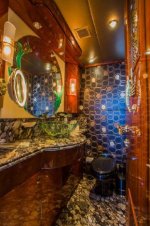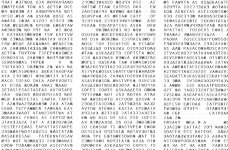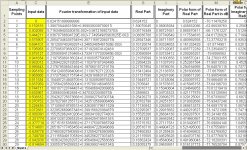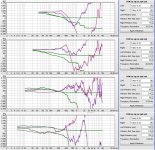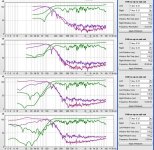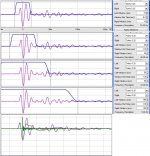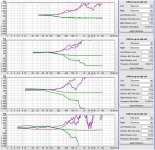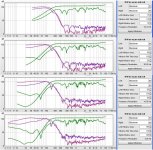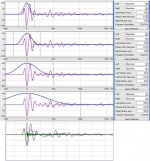The full article :
http://www.americanradiohistory.com/Archive-Poptronics/70s/1977/Poptronics-1977-09.pdf
http://www.americanradiohistory.com/Archive-Poptronics/70s/1977/Poptronics-1977-10.pdf
Hope Richard wouldn't mind,
Patrick
http://www.americanradiohistory.com/Archive-Poptronics/70s/1977/Poptronics-1977-09.pdf
http://www.americanradiohistory.com/Archive-Poptronics/70s/1977/Poptronics-1977-10.pdf
Hope Richard wouldn't mind,
Patrick
but not the palate.
Bathroom of a 120ft superyacht, 110% custom-built for a well-known Palm Springs heart surgeon.
Technically a quality yacht, but top to bottom as tacky as it can possibly get.
Zebra & Tiger print motif everywhere, from pillows to couch upholstery, porthole curtains to walls, mirror edge 'decoration' to bathroom sinks.
The good doctor put it up for sale after 4 years, his palatoschisis cost him a write-off of close to three quarter on the initial build cost in 2007.
Attachments
EUVL -- Not At all.
I learned a lot about acoustics, EQ, speakers etc with that and then other equipment over the decades.... I make feeble attempts here to tell some results with limited acceptance when ever the occasion arises.
THx-RNMarsh
I learned a lot about acoustics, EQ, speakers etc with that and then other equipment over the decades.... I make feeble attempts here to tell some results with limited acceptance when ever the occasion arises.
THx-RNMarsh
Reverberation time until the stimulus has dropped by 60dB.
Thank you, Abraxalito.
Answer is - no idea. It workes fine enough for me, I never bothered making any measurements as I saw no point to them. I cannot change the room furnishings as they were made to order, custom made and installed for me. To change anything of significance I'd have to redo the lot, which is out of the question.
The full article :
http://www.americanradiohistory.com/Archive-Poptronics/70s/1977/Poptronics-1977-09.pdf
http://www.americanradiohistory.com/Archive-Poptronics/70s/1977/Poptronics-1977-10.pdf
Hope Richard wouldn't mind,
Patrick
Patrick, a great find! Nice article by Richard and his friend, I remember it vividly, wanting to build it but never got to it.
And DO scan the ads - a $ 995 floppy for your computer??
Jan
Richard,
It obviously wasn't the unit that you built but it was around that same time that I used my first 1/3 octave analyzer. Takes me back. I guess you started that whole thing. What I remember was it was rather difficult to make any real conclusion or get any fine details but it did show trends. I was using that to look at some of the first horns that I designed. as I said it just showed me some trends in what was happening but it was very educational. .
Great work on your part.
It obviously wasn't the unit that you built but it was around that same time that I used my first 1/3 octave analyzer. Takes me back. I guess you started that whole thing. What I remember was it was rather difficult to make any real conclusion or get any fine details but it did show trends. I was using that to look at some of the first horns that I designed. as I said it just showed me some trends in what was happening but it was very educational. .
Great work on your part.
Such things were of a time when the hobby was prevalent and prob the only affordable way for the amateur to go. Halcyon days! Noble stuff, however swept heterodyne analysers do pre-date it by decades..........You are very close to being the grand winner ! It was 1977.
One of the great puzzles. What was the rational behind it?George knows what it means. 🙂
Pausanias (Attika 5.17.6) provided only a description, no explanation
When a co-worker was looking at FFT boxes many years ago, he asked "so these are real-to-real?"
The salesman said, "Well, we actually prefer cassettes."
<rimshot>
This made the day for me Brad, thanks
George
Attachments
Aside, did you know that Fourier Transform results are naturally complex numbers, even when fed with entirely real time samples? That is to say, the result includes phase info for discrete frequencies, which fact is generally disregarded or ignored for reasons unknown.........same is true of heterodyne detectors, in a very different way of course........
I had made a spreadsheet doing FFT just for the phase info. You can see the complex numbers
http://www.diyaudio.com/forums/software-tools/195457-spreadsheet-can-do-spectral-magnitude-phase.html#post2688368
George
Attachments
Bathroom of a 120ft superyacht, 110% custom-built for a well-known Palm Springs heart surgeon.
Technically a quality yacht, but top to bottom as tacky as it can possibly get.
Zebra & Tiger print motif everywhere, from pillows to couch upholstery, porthole curtains to walls, mirror edge 'decoration' to bathroom sinks.
The good doctor put it up for sale after 4 years, his palatoschisis cost him a write-off of close to three quarter on the initial build cost in 2007.
Oh my goodness that is terrible.
If I had money to burn I'd sail it out beyond territorial waters and sink it
😀
Thanks, George - yes that's right. A common sense explanation is that a fourier transform converts the waveform time clip into a set of discrete sinewaves of frequency, amplitude and phase. Which, when combined, describe the waveform for the time clip. In this way, the result contains both amplitude and phase info for all discrete frequencies in the sample waveform.I had made a spreadsheet doing FFT just for the phase info. You can see the complex numbers
http://www.diyaudio.com/forums/software-tools/195457-spreadsheet-can-do-spectral-magnitude-phase.html#post2688368
George
Just that no-one bothers to present the phase info.........
BTW Excel's FFT has limitations but produces correct results. To overcome restrictions of, say, sample size it's better to borrow VB code and insert into a macro. I wrote one for myself, will dig it out if I can find it and post it.
You are welcome.Thanks, George - yes that's right
I hope you’ll find the VB code.
George;
Your results are disorienting and disoriented.
Phase plots of electrical response correspond to wrong point for t=0.
If FR plot shows real behavior of woofer it is passing way too much signal both below 20Hz and above 200Hz.
15ms-25ms half windows of a Blackman flavor likely will give you the most useful information. Look for window that shows deepest null at crossover with polarity reversed on one of the drivers.
Barleywater
I followed your advice. I hope the plots now make more sense to you (they are from the same scenario: LP & HP 48dB/oct LR at 140Hz, electric and acoustic measurements)
Review them and tell me please which of the window functions you find as most appropriate in this case for extracting meaningful results (and if possible why)
George
Attachments
One of the great puzzles. What was the rational behind it?
Pausanias (Attika 5.17.6) provided only a description, no explanation
Bob Pease taught me that and I always wanted a use for it. When you plow with an ox you go back and forth, the word is used to mean back and forth writing just like the minimum phase IIR filters are done back and forth.
BTW Excel's FFT has limitations but produces correct results. To overcome restrictions of, say, sample size it's better to borrow VB code and insert into a macro. I wrote one for myself, will dig it out if I can find it and post it.
I've switched to Python, no serious limitations arbitrary N too.
Deconvolution in action
New Horizons sees Pluto?s close approach hemisphere and Charon’s ‘darkpole’ | Astronomy Now
New Horizons sees Pluto?s close approach hemisphere and Charon’s ‘darkpole’ | Astronomy Now
Here's a copy, rough as it may be hopefully you can get the gist. I'm certain there will be better out there, but it does the job. N holds the number of samples, has to be a power of 2. No guarantees, just for fun and info.I hope you’ll find the VB code.
Attachments
Thanks luckythedog for the code. I will check it later on.
Very well. We agree that this is an ingenious way for a moving-scanning device or procedure to do work efficiently minimizing dead time.
The puzzle is why they did it in that distant past. For those people at that period in history, that way of writing was the most inefficient possible. Not because the lines of letters were changing direction starting from left and proceeding toward right, the next line starting from right and proceeding toward left ect, but because with every direction change the letters and number symbols had to switch direction too, i.e. they were written as mirror images .
Think of the man who was engraving whole legal codes on stone. (my attachment was from https://en.wikipedia.org/wiki/Gortyn_code )
Reading a script written in that fashion though, is another thing.
During the last grades of elementary school, we were exercised to read in such a format. I remember it was fun.
It may sound strange but we got used to it very easily (it made reading a game play, less boring) and yes, for reading it is an efficient format.
The more I thing over it, the more I lean toward the efficiency in reading as the explanation.
Write once (the inefficient part), read multiple times (the efficient part).
Yes, it makes sense. The text lines were very long and it was easy for the reader to miss a line if he had to walk a distance to find the beginning of the next line.
The very interesting in this case is that, it seems they had realized empirically what we today have learned through research: That reading is actually accomplished through scanning images of words in a row rather than assembling individual letters.
Thank you for giving me the opportunity to think over it.
George
Bob Pease taught me that and I always wanted a use for it. When you plow with an ox you go back and forth, the word is used to mean back and forth writing just like the minimum phase IIR filters are done back and forth.
Very well. We agree that this is an ingenious way for a moving-scanning device or procedure to do work efficiently minimizing dead time.
The puzzle is why they did it in that distant past. For those people at that period in history, that way of writing was the most inefficient possible. Not because the lines of letters were changing direction starting from left and proceeding toward right, the next line starting from right and proceeding toward left ect, but because with every direction change the letters and number symbols had to switch direction too, i.e. they were written as mirror images .
Think of the man who was engraving whole legal codes on stone. (my attachment was from https://en.wikipedia.org/wiki/Gortyn_code )
Reading a script written in that fashion though, is another thing.
During the last grades of elementary school, we were exercised to read in such a format. I remember it was fun.
It may sound strange but we got used to it very easily (it made reading a game play, less boring) and yes, for reading it is an efficient format.
The more I thing over it, the more I lean toward the efficiency in reading as the explanation.
Write once (the inefficient part), read multiple times (the efficient part).
Yes, it makes sense. The text lines were very long and it was easy for the reader to miss a line if he had to walk a distance to find the beginning of the next line.
The very interesting in this case is that, it seems they had realized empirically what we today have learned through research: That reading is actually accomplished through scanning images of words in a row rather than assembling individual letters.
Thank you for giving me the opportunity to think over it.
George
Would one of you happen to know the ballpark value for the self-resonance of this Hammond 10H common mode choke?
157H Hammond Manufacturing | Mouser
157H Hammond Manufacturing | Mouser
Its not common-mode, the datasheet shows just two wires, a simple inductor.
Mouser states its 60Hz but I think that's in error - very,very ballpark figure I'd put around 3kHz?
Mouser states its 60Hz but I think that's in error - very,very ballpark figure I'd put around 3kHz?
That's plausible, as the distributed C would be 281pF.Its not common-mode, the datasheet shows just two wires, a simple inductor.
Mouser states its 60Hz but I think that's in error - very,very ballpark figure I'd put around 3kHz?
- Status
- Not open for further replies.
- Home
- Member Areas
- The Lounge
- John Curl's Blowtorch preamplifier part II
